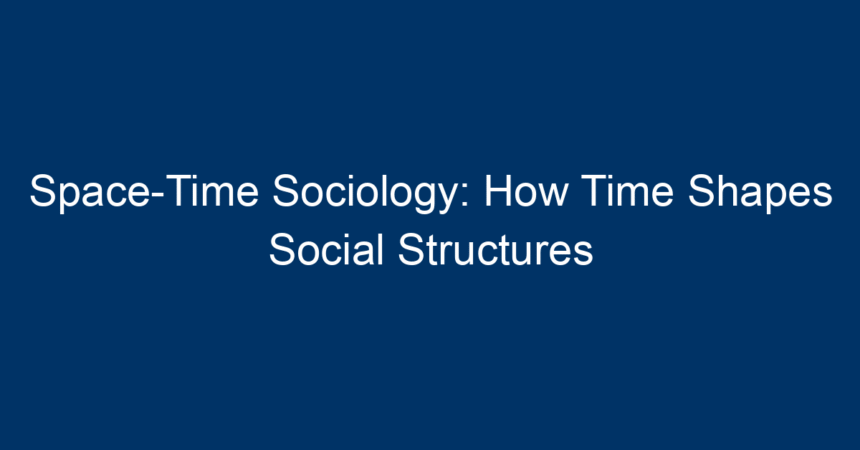In an increasingly interconnected world, the fabric of our societies is woven through complex interactions that merge both space and time. This concept, known as space-time sociology, explores the intricate relationship between social structures and the temporal dimensions that influence them. Understanding how time shapes these structures not only allows us to comprehend the dynamics of social interactions but also provides insights into our collective future.
The Foundations of Space-Time Sociology
Understanding Space-Time
At the core of space-time sociology lies the integration of spatial and temporal dimensions. In sociology, “space” refers to the geographical and cultural contexts where social phenomena occur, while “time” encompasses the historical and evolving nature of social practices. Together, these dimensions shape human behavior, societal norms, and institutional frameworks.
The Historical Perspective
Historically, sociologists have recognized the importance of time in shaping societal transformations. Thinkers like Émile Durkheim and Max Weber examined how different historical epochs influenced the social fabric. With the rise of industrialization, for instance, traditional community bonds weakened, replaced by more fragmented, individualistic societies. Understanding this historical trajectory is crucial for grasping modern social dynamics through the lens of space-time sociology.
The Role of Time in Social Structures
Social Change and Temporal Dynamics
Time is a powerful catalyst for social change. Events such as revolutions, technological advancements, and shifts in cultural norms illustrate how specific moments can alter social structures. For example, the digital revolution has reshaped communication patterns, leading to the formation of new social networks and communities that transcend geographical limitations.
Temporal Hierarchies in Society
Our understanding of time is not uniform; it varies across cultures and social groups. This variation leads to the formation of temporal hierarchies, where certain timeframes, like work hours or school schedules, dominate social interactions. For instance, in many Western societies, the strict adherence to linear time affects work-life balance, productivity, and even social relationships. In contrast, cultures with a more fluid perception of time may prioritize community interactions over rigid schedules.
Space-Time Interactions: A Sociological Perspective
Geographic Context and Social Dynamics
The interplay between space and time is especially evident in geographic contexts. Urban areas typically showcase accelerated social interactions due to the density of populations and accessibility to resources. In contrast, rural areas may see slower social processes, emphasizing traditional practices and long-standing relationships.
Case Studies: Urban vs. Rural Dynamics
Consider cities like New York, where the fast-paced lifestyle encourages transient relationships and networking. Here, time is often perceived as a scarce resource, compelling individuals to maximize immediate interactions. In contrast, rural settings may foster deeper connections through prolonged social encounters, as individuals often share a common history and culture.
Social Institutions and Time
Social institutions, such as family, education, and religion, are also profoundly influenced by temporal factors. Educational timelines dictate when individuals enter the workforce, while family structures may revolve around generational timelines. Understanding these timelines is essential for grasping the evolutionary nature of these institutions.
The Impact of Modernity on Space-Time Sociology
Globalization and Its Temporal Effects
In today’s globalized world, the dynamics of space-time sociology are becoming increasingly complex. Globalization introduces a new temporal dimension, altering how cultures interact and influence one another. The immediate flow of information, goods, and services across borders accelerates social change but also creates challenges such as culture shock and identity crises.
The Digital Age: Redefining Time and Space
The emergence of digital technology has fundamentally transformed our perception of time and space. Virtual spaces allow for asynchronous communication and social interactions that defy traditional temporal constraints. This raises critical questions about the nature of community and belonging in a digital landscape where geographical barriers are diminished.
Practical Implications of Space-Time Sociology
For Policymakers
Understanding space-time sociology can inform public policy in various sectors. Urban planners, for instance, can utilize insights from spatial-temporal dynamics to create more inclusive communities that account for diverse temporal perspectives.
For Educators
Educators can also benefit from embracing the principles of space-time sociology. By recognizing that students come from various temporal backgrounds, teachers can develop curricula that respect these differences, fostering a more inclusive learning environment.
For Individuals
On a personal level, understanding the dynamics of space-time sociology equips individuals with tools to navigate their social interactions more effectively. By recognizing how their own perceptions of time and space shape their relationships, individuals can forge deeper connections and foster a greater sense of community.
Actionable Insights for Embracing Space-Time Sociology
-
Reframe Your Perspective: Consider how your perceptions of time influence your social interactions and relationships. Are you adhering to rigid schedules, or can you embrace a more fluid understanding of time?
-
Cultivate Awareness of Diversity: Acknowledge that different cultures have varying interpretations of time, which can help enhance communication and mutual respect in diverse settings.
-
Engage in Reflective Practices: Take time to reflect on your social interactions and community involvement. How can you engage more meaningfully with those around you, regardless of temporal constraints?
-
Create Inclusive Environments: Whether at work or in your community, foster spaces that respect diverse temporal perspectives. This can lead to more harmonious interactions and collaborations.
- Stay Informed: Follow emerging trends in space-time sociology and be open to new insights that can help you navigate an increasingly complex social landscape.
Conclusion: Embracing the Future of Space-Time Sociology
As societies continue to evolve in a rapidly changing world, the study of space-time sociology becomes increasingly relevant. By understanding how time shapes social structures, individuals and communities can navigate the complexities of modern life with greater awareness and empathy. The interplay of spatial and temporal dynamics offers a lens through which we can examine our past, understand our present, and envision our future.
In this ongoing journey, embracing the principles of space-time sociology can empower us to build more equitable, inclusive, and resilient societies. As we stand at the crossroads of tradition and transformation, let us harness the insights of space-time sociology to create a brighter, more connected future for all.




